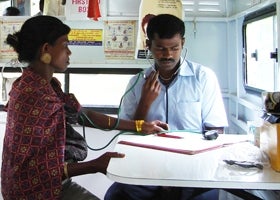 Back in the mid-1980s, India's then-Prime Minister Rajiv Gandhi lamented that out of every rupee spent on welfare schemes, only 15 paise reached the poor. More than a quarter of a century later, the scale and ambition of India’s social sector programs have become far bigger than what even Rajiv’s 21st-century vision could have comprehended. But one thing has remained constant – the system still leaks.
Back in the mid-1980s, India's then-Prime Minister Rajiv Gandhi lamented that out of every rupee spent on welfare schemes, only 15 paise reached the poor. More than a quarter of a century later, the scale and ambition of India’s social sector programs have become far bigger than what even Rajiv’s 21st-century vision could have comprehended. But one thing has remained constant – the system still leaks.
That’s not to say the problem hasn’t received attention. There is increased awareness about pilferage and diversion of assets meant for a target population. Programs now are better designed to detect leakages, estimate what’s being delivered and allow monitoring at various stages.
But these measures have met with varying degrees of success. Clearly some states – and indeed some projects – have been better at drawing benefits and utilizing funds than others.
So how do you get more bang for your buck when it comes to development projects? When the World Bank invited me to visit some of its assisted projects in Tamil Nadu in early May this year, I got a firsthand opportunity to mull this issue.
In terms of design and implementation, the projects we saw appeared to be among the best in the country. Here are the top three insights I got from my interactions during the trip on how projects should be structured for better results.
More power to the beneficiary: The Pudhu Vaazhvu project of the state government’s rural development department is a poverty-reduction initiative meant to benefit Tamil Nadu’s poorest. Among the innovations the project implemented was to do away with NGOs in running self-help groups. Instead, the project trained the beneficiaries to themselves run their SHGs.
The results, as we saw during a field visit to Kancheepuram district, were more than encouraging. The beneficiaries had a sense of ownership of the project. They were also becoming confident in making use of economic opportunities in their areas.
Keep it simple and transparent: Transparency, it has been universally acknowledged, is the most crucial element of a project design. In the Road Management System under the Tamil Nadu Road Sector Project, transparency is being used for a patently different purpose – to settle competing claims from political representatives for maintenance of roads in their respective constituencies.
By drawing up objective, scientific criteria for which roads should get priority in repairs – and putting them up in its website – the state highways department has done away with a potential source of political heartburn and accusations, besides, of course, making the system logic-based and simple to understand.
Consolidate information: The importance of accurate data collection and record-keeping cannot be overstated. They not only provide proof of the success or failure of a project, data often improve efficiency and have uses in research. We were happy to find data being collected for a variety of ends in the different projects we visited.
The hospital management information system, which has hooked up most of the state’s government hospitals through a common server, has been centralizing patient information that will not only improve Tamil Nadu’s health system but also provide baseline data for research on disease trends. The statewide EMRI ambulance service project too has been keeping call records and using it to delineate trends.
States where mega-flagship projects are failing would do well to pay attention to these practices. These could help them plug the leaks and script a turnaround.


Join the Conversation